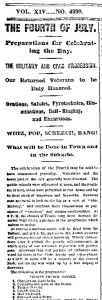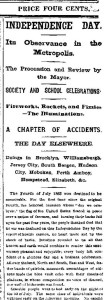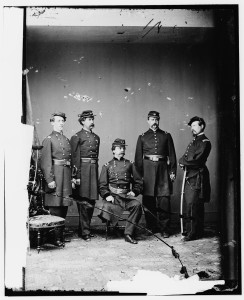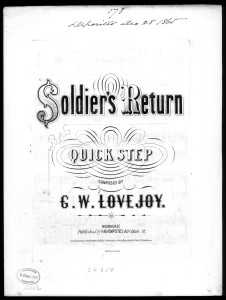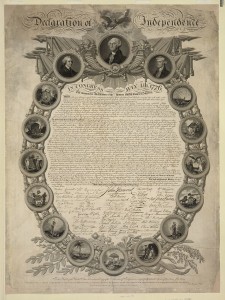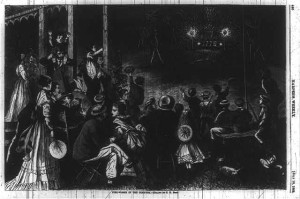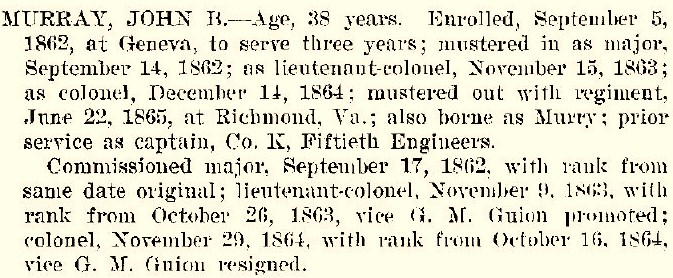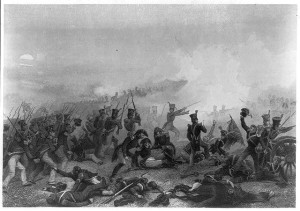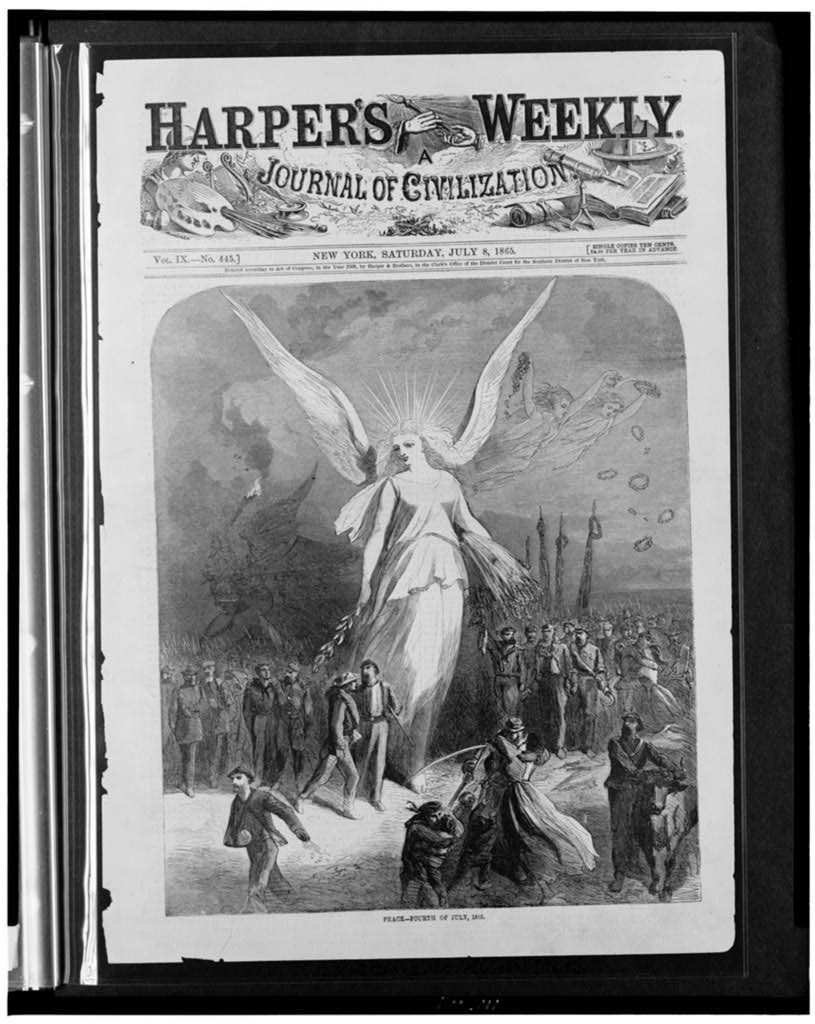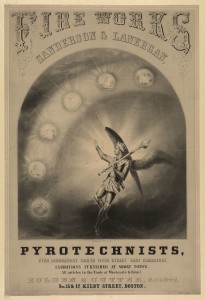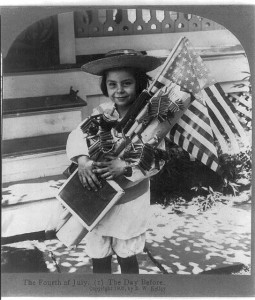From The New-York Times July 6, 1865:
THE CELEBRATION OF INDEPENDENCE DAY.
The observance of the National Anniversary was characterized everywhere throughout the country by a sober heartiness and earnest enthusiasm, in perfect keeping with the peculiarities of the occasion. The public fully appreciated the moral grandeur of the festival. The all-pervasive sentiment, finding its expression in public utterances and private merrymakings, was profound gratitude at the happy issue of the terrible ordeal through which the nation has just passed victoriously. This feeling of gratitude, though dominant, was tempered, nevertheless, by the saddened memories which must cling for long, long years to the epoch of the rebellion. There was devout joy at the salvation of the country, redeemed from the dark stigma of slavery, and established on surer and better foundations as the land of a free people, whose right to self-government has been vindicated before the world, and whose success finds a response of thankfulness in the hearts of the down-trodden and oppressed among all peoples. There were also the sorrowful remembrances of homes made desolate, families bereft, broad lands devastated, and great cities laid waste by fratricidal strife. No wonder, then, that the day was fraught with conflicting emotions, and was not the less fruitful of sober thoughtfulness than exhuberant patriotism.
In all the demonstrations yesterday the gallant men to whose courage and endurance the nation owes its life, received, as was meet they should, the homage of a grateful people. Their’s was the honored place in the public celebrations and at the festive board. The people themselves mingled harmoniously together, everywhere imbued with the same spirit of devout gratitude and unselfish patriotism, animated by the same noble sentiment which the late President so forcibly expressed, of “malice toward none — charity for all,” and thus showed in their manner of observing the day that they were worthy of the heritage of a free and enlightened republic.
General Grant attracted a lot of attention as he traveled by train from New York City to Albany on the Fourth. At Albany General Butterfield presented many New York regimental battle-flags to Governor Fenton. Further North in Saratoga another Union general urged a charitable policy towards the defeated rebels. From a Seneca County, New York newspaper in July 1865:
GENERAL SICKLES, who lost a leg during the rebellion, was at Saratoga on the 4th and made a speech on the state of the country. He simply urged the policy of mercy and fraternity towards the subjugated foe, and made this pointed thrust at the radical hyenas who thirst for the blood of the prostrate victims: “If those who have served their country in the field can can sincerely look with these sentiments upon those with whom they have been so lately engaged in battle, then, I think the civilians throughout the land – especially the politicians who have done so much to get us into this war – can do so.
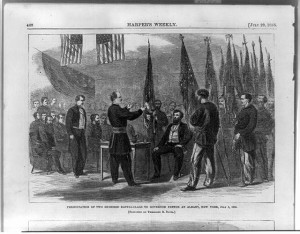
“Presentation of two hundred battle-flags to Governor Fenton at Albany, New York, July 4, 1865 / sketched by Theodore R. Davis. ” (Library of Congress)
____________________________________________________________________
In Seneca Falls, New York the day was beautiful, the war had ended, peace, returned soldiers marched in the procession and were honored. Unfortunately, the fireworks were only fair. From a Seneca County, New York newspaper in 1865:
The Celebration.
The celebration of the Fourth of July in this village was in all respects a successful and imposing demonstration. The weather was propitious and the occasion one of no ordinary interest. At an early hour the people began to assemble and by the time the procession commenced forming a very large crowd thronged the streets, all anxious and eager to participate in the festivities of the day. The morning train from the west brought in the splendid Band of the 148th regiment, and large delegations from neighboring towns. At 10 o’clock the procession was formed on State street under Brigadier General Guion and his assistants, and conducted through the principal streets to the Park, where a large stand had been erected for the occasion. In the procession were a large number of returned soldiers of the 15th and 50th Engineers, the 148th regiment, the 8th cavalry and the 3d Artillery, bearing their appropriate colors, and preceded by a fine band of martial music. Conspicuous in the procession were the colors which the gallant 148th regiment had borne through so many sharp engagements. The boys of the 8th cavalry carried a banner upon which was inscribed “Heroes of Sixty-four Battles.”There were also quite a number of veterans of 1812 in the procession, among the number our venerable friend Gen. Z.A. Disbrow, of Waterloo. During the parade through the streets the reception of the returned soldiers was most enthusiastic, they being the object of the attention of all. The music of the 148th Band was particularly fine during the march.
The exercises at the Park were of a very pleasant character. The President of the day, Mr. Abram Failing, announced the order of exercises, which consisted of prayer by the Rev. Mr. Baker, the reading of the Declaration of Independence by Charles A. Hawley, Esq., an an oration by Col. John B. Murray, interspersed with patriotic airs by the Band of the 148th. Mr. Hawley read the Declaration of Independence very acceptably, and Col. Murray spoke with his accustomed force, vigor and eloquence. His remarks were most favorably received. Immediately after the oration, Col. Johnson alluded to the proposition for an erection of a suitable monument to those from our town who have fallen in the defense of the government, announcing that a meeting for that purpose would be held at Union Hall this (Friday) afternoon.
After the benediction by the Rev. Mr. Oakley of the baptist Church, the procession re-formed and marched to Union Hall where a sumptuous dinner had been provided by the ladies of the place. The tables were bountifully supplied with all the substantials and delicacies of the season and their appearance reflected much credit upon all interested in their arrangement. Not being present at the Hall we cannot particularlize as to what occurred, but learn that everything passed off most agreeably to all.
The Horse fair brought together a large concourse of people and was one of the most attractive features of the day. It was all respects a success.
The Fireworks in the evening were fair, but not brilliant. The exorbitant price of every thing of a pyrotechnical character precluded the committee from the purchase of many very brilliant pieces. No accident occurred during the display, and the people generally expressed themselves satisfied with the entertainment.
This closed the Fourth so far as relates to the public celebration. The affair was creditable to all concerned, and every way worthy of the day of the occasion.
The success of the Horse Fair kind of reminded me of the popularity of classic car shows today – people admiring a good-looking ride?
From a Seneca County, New York newspaper in July 1865:
Brigadier General Disbrow.
Our old fellow townsman, Brig. Gen. Zalmon A. Disbrow, was ferried across Cayuga Lake last Fourth of July, it being just seventy years since he came into our county by the same route. Since the year 1795 General Disbrow has been a citizen of Seneca county. Occupying an honorable and distinguished post in the last war with Great Britain, his martial spirit has burned with unabated fire thro’ the winter of his declining years. In grateful remembrance of military services rendered, the State conferred upon him, last year, the star of a Brigadier of Veterans of 1812.
During the past war he has been as unswerving and earnest in his loyalty as his record would indicate. His voice and influence have been for that country his young arm helped sustain, and his action such as we might expect from one whose maiden vote was cast for Jefferson, and whose bold heart dared the battle’s front at Queenstown Heights and Lundy’s Lane. – Waterloo Observer.
________________________________________________________________
________________________________________________________________

